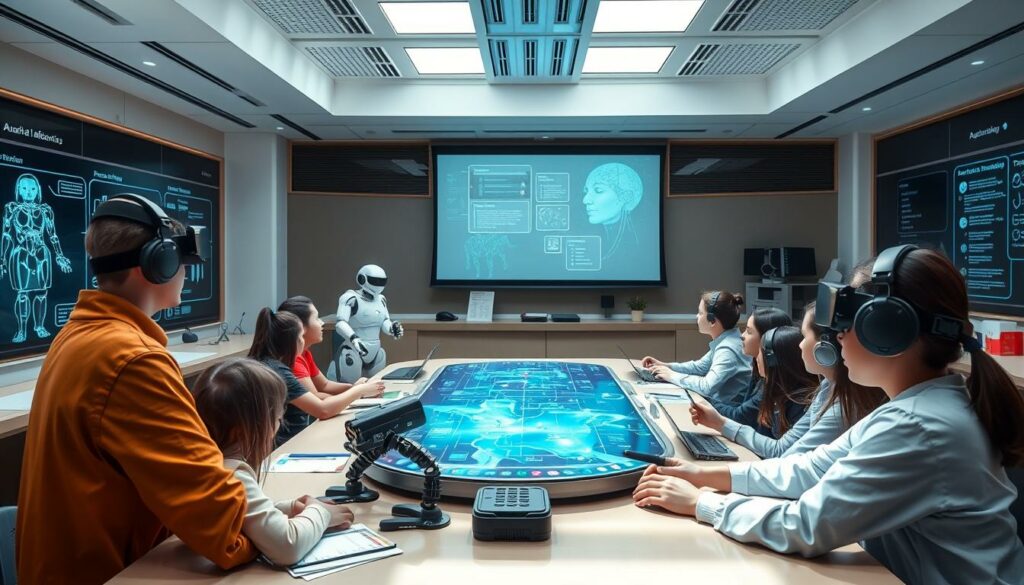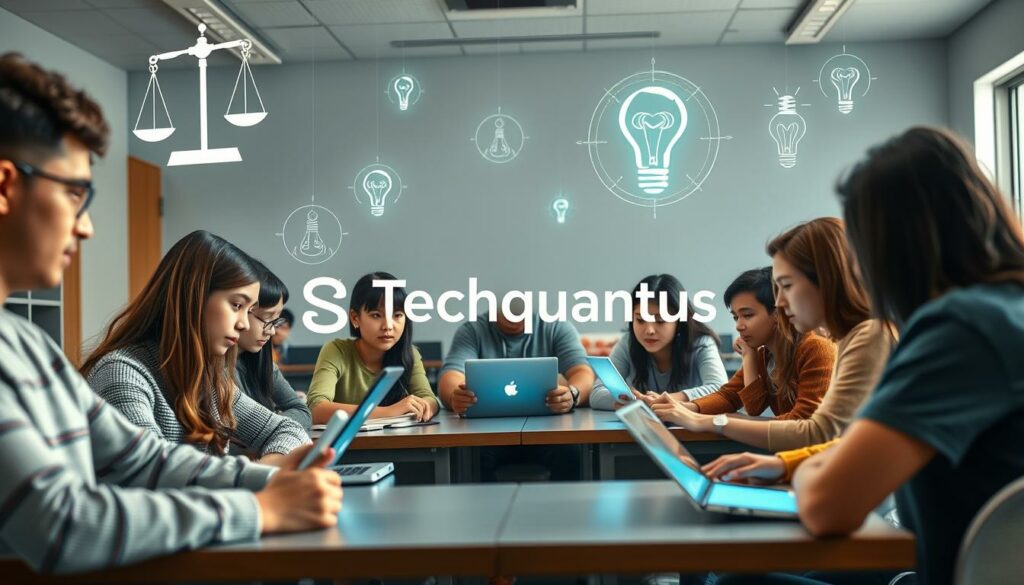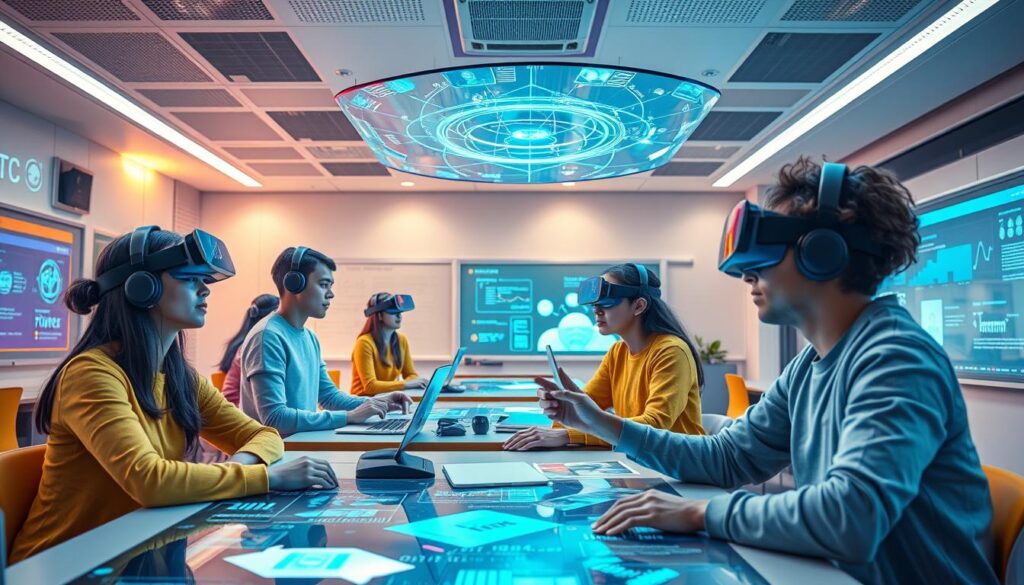Did you know that schools using Artificial Intelligence tools see a 30% jump in student interest? This fact shows how big of an impact AI is having on education. As technology grows, so does the way we teach and learn. It’s key for teachers and students to keep up with these changes.
AI is changing education for the better. It makes learning more personal, efficient, and open to everyone. For instance, adaptive learning systems adjust the curriculum to fit what each student needs. Tools like EarSketch are making coding education available to visually impaired students, thanks to funding from the National Science Foundation. This shows how AI is pushing education forward, making it more inclusive and accessible.
AI’s benefits go beyond just helping students learn on their own. It uses data to improve teaching and gets students ready for a future shaped by technology. As we look into AI’s role in education, think about how it can make your learning better and the new experiences it offers.
For more on how technology is changing education, check out this resource.
Key Takeaways
- AI tools can increase student engagement by up to 30%.
- Projects like EarSketch highlight the need for inclusion in coding education.
- Data-driven insights from AI help educators tailor their teaching methods.
- Adaptive learning technologies customize the curriculum to each student’s needs.
- AI’s integration supports accessibility and inclusivity in mixed learning environments.
Introduction to AI in Education
AI technology has changed education in big ways, making teaching and learning different. Schools are using AI to improve education. This change is bringing new tech solutions that help students and teachers.
AI tools are making learning easier. They offer personalized learning and new ways to test students. This helps teachers make learning fun and effective for everyone.
AI is set to do even more in the future. Schools are updating their programs to include AI. This means students get learning experiences that are just right for them. Exploring AI shows how it can make education better.
- Automation of administrative tasks
- Intelligent tutoring systems
- Data analysis for student performance tracking
- Completion of policies regarding privacy and data collection
Using AI brings big changes to education. As you learn more, you’ll see how AI is changing education. It’s becoming key to how we learn today.
Enhancing Learning Experiences with Technology
Technology is changing how we learn by offering new ways to learn. We see personalized learning paths and adaptive learning systems. These methods help students reach their goals better and faster.
Personalized Learning Paths
Personalized learning lets teachers tailor lessons to each student’s needs. This way, students move at their own speed, using their strengths and interests. Thanks to tech, students can really shine.
AI helps by giving students learning tips based on how they’re doing. This makes learning fun and builds a love for it.
Adaptive Learning Systems
Adaptive learning uses smart algorithms to check how students are doing and give them what they need right away. This makes learning more engaging and helps students do better. It makes sure students get help when they need it.
Looking into educational tools shows how these technologies make learning more personal.
| Feature | Personalized Learning | Adaptive Learning Technology |
|---|---|---|
| Approach | Student-centered customization | Real-time performance analysis |
| Feedback | Periodic assessments | Instant, tailored responses |
| Goal | Enhance individual learning journeys | Maximize engagement and outcomes |
Education is changing fast, and tech is leading the way. Personalized and adaptive learning systems are making learning better and preparing students for the future. For more on AI’s impact, check out this resource.
The Role of Artificial Intelligence in the Classroom
AI is changing how classrooms work. Schools use AI tools to help teachers with different challenges. This makes teaching and learning more effective.
At David Game College in London, an AI system personalizes lessons for each student. It looks at what each student is good at and where they need help. This makes learning more personal and effective.
Arizona State University (ASU) has brought in ChatGPT, an AI chatbot, for students. It helps with tasks like healthcare simulations and research. Students get support in real-time, making their learning easier.
AI tools have many benefits but also raise concerns about how they affect students. We need to think about how AI changes how students interact with each other. Adding “learning coaches” can help where technology falls short, like in art or sex education.
David Game College shows how AI can improve education. The use of AI in schools is still growing. It brings both new opportunities and challenges, showing AI’s value in the classroom.
Benefits of AI Tools for Educators
AI tools for teachers make the classroom better. They boost educational efficiency and help teachers manage their work well. By doing routine tasks automatically, AI lets teachers spend more time with students and give personalized lessons. This makes learning better for everyone.
Efficiency and Time Management
AI helps with tasks like grading and keeping track of students. This means teachers can do more in less time. They can focus on what’s important: engaging with students and creating lessons. This change makes teaching more efficient for everyone.
Data-Driven Insights for Teaching
AI changes how teachers see how students are doing. It gives insights on what students learn best and where they need help. Teachers can use this info to make their lessons better suited for each student.
| Benefits of AI Tools | Impact on Educators | Impact on Students |
|---|---|---|
| Time Savings | Reduces time spent on administrative tasks | More time for personalized support |
| Data Insights | Facilitates informed decision-making | Identifies learning gaps quickly |
| Resource Management | Streamlines educational resources | Enhances access to learning materials |
| Improved Engagement | Encourages interactive teaching methods | Boosts student motivation and participation |
AI in Assessment and Evaluation
AI assessment tools are changing how we evaluate students in education. These evaluation technologies make grading faster, giving students instant feedback on their work. Schools and teachers gain from these tools, as they make teaching evaluation more objective and consistent.
AI has brought big changes to how we evaluate students. Before, grading and giving feedback took a lot of time. Now, AI helps speed up these tasks, letting teachers focus more on making learning fun.
Using AI in education leads to fairer evaluations. It helps avoid biases that can happen with manual grading. This means students are judged more fairly, promoting honesty in school. But, we must remember that AI has its limits, like needing old data and models.
We need to think carefully about how AI works in school, especially with big language models (LLMs). For more on the challenges of AI in education, check out this article about its effectiveness and usefulness. It’s important to know how to use AI right to get the best results.
Overall, AI is changing education in big ways. It promises to make grading more efficient and fair, helping us better understand and improve student skills.
Challenges of Implementing AI in Education
Adding artificial intelligence to schools faces many hurdles. One big issue is making sure all students can use AI’s benefits. Not all students have the same access to AI tools because of differences in resources. It’s crucial to fix this to keep learning fair for everyone.
Equity and Access Issues
AI can make learning better, but not everyone has the same chance to use it. Some students lack technology at home, giving them a disadvantage. This means they might not keep up with their classmates who have more access to AI.
- Discrepancies in technological infrastructure between urban and rural areas.
- The gap in access to internet connectivity among different socioeconomic groups.
- Variations in school budgets that affect the procurement of AI tools.
Teacher Training and Adaptation
Teachers need help to use AI in the classroom well. They must learn new ways of teaching with technology. Without training, teachers might not know how to use AI tools properly.
- Inadequate resources for ongoing teacher training programs.
- Resistance to change among some educators due to unfamiliarity with technology.
- The learning curve associated with adopting AI tools in existing curricula.
Fixing these problems needs effort from schools, teachers, policymakers, and tech companies. Working together can make learning better for everyone.
| Issue | Description | Impact |
|---|---|---|
| Equity in Access | Lack of technological resources for some students | Creates disparities in educational outcomes |
| Teacher Training | Inadequate professional development in AI | Limits effective integration of AI tools |
| Resistance to Change | Some educators may prefer traditional teaching methods | Hinders the adoption of innovative learning solutions |
Future Trends in Educational Technology
The world of educational technology is changing fast, with a focus on new technologies and teamwork. VR in education and AR in classrooms are leading the way in making learning more fun and interactive. These tools help students dive deep into their studies, making it easier to remember and understand.
Integration with Virtual and Augmented Reality
Virtual and augmented reality are changing how we teach, making learning more exciting. With educational technology trends, classrooms are becoming places where students can explore and discover. For example, students can visit historical sites or see the human body in 3D, making tough topics easier to grasp.
This hands-on learning grabs students’ attention and suits different ways of learning.
Collaboration with Educational Institutions
Working together, schools and tech companies are pushing learning forward. These partnerships help create new solutions. For example, the Georgia Institute of Technology is making coding easier for visually impaired students with EarSketch. This shows how we can make learning accessible for everyone. You can learn more about this here.

As we look to the future, VR and AR will be key in changing how we learn. By combining immersive experiences with teamwork, we can create AI tools that solve real learning problems. This will improve how students learn in all kinds of settings.
| Trend | Description | Impact |
|---|---|---|
| VR in Education | Creates immersive learning experiences through virtual environments. | Enhances engagement and understanding of complex subjects. |
| AR in Classrooms | Incorporates digital information overlaid on the real world. | Allows for interactive and experiential learning opportunities. |
| Collaborative Partnerships | Brings together educational institutions and tech companies. | Facilitates the development of innovative, inclusive educational tools. |
Real-World Examples of AI in Education
Schools across the United States show how AI changes education for the better. They use new tech to give students lessons that fit their needs. For example, language learning apps adjust the difficulty level based on how well each student does.
Intelligent tutoring systems are another great example. They help students who need extra help right away. This tech makes learning fun and easier for everyone.
Looking closely at these AI examples in education shows their big benefits:
- Students get more involved in their learning with interactive tools.
- They remember more because they get exercises that match their level.
- Teachers can improve their teaching by using data to guide them.
These examples show how schools can get better with AI. As teachers use AI, education looks set to get even better. It will make students more passionate and understanding about learning.
Ethics of Artificial Intelligence in Education
AI technology in education raises big ethical questions. Teachers and those making education policies need to think hard about these issues. They must look at data privacy, being clear about how things work, and avoiding bias in AI. These things can really change how students learn and do well.
Schools face big challenges with privacy in using AI. They need to keep student data safe as they use AI tools. These tools need lots of data to help with learning and school tasks. Schools should make sure they follow the rules to keep students safe online.
AI can also be biased if it’s trained on bad data. This can mean some students get treated unfairly, making things worse for them. Teachers need to talk about how AI works and the risks of unfair decisions.
It’s important to teach staff about using AI ethically in education. Training should cover how to use AI right and make sure everyone feels included and treated fairly.

Understanding these ethical issues is key to using AI wisely in schools. By being careful and having strong ethical rules, schools can use AI’s benefits. They can protect students’ rights and keep their data safe.
The Impact of AI on Student Engagement
Artificial intelligence has changed how students engage with learning. AI helps create interactive classrooms that make students want to take part more. These classes are not just more fun but also build a sense of community among students.
Interactive Learning Environments
AI makes learning more engaging and dynamic in interactive classrooms. It uses tools that adjust to how each student learns best. This makes learning personal and interesting for everyone.
For example, EarSketch, a tool from 2011, now helps visually impaired students learn coding through music. It makes learning complex ideas fun and interactive. You can learn more about teaching coding to visually impaired students here.
Gamification in Learning
Gamification makes learning more engaging by adding game-like elements to lessons. This approach makes learning fun and encourages students to work together and think critically. Educators like Sue Sullivan use interactive tools to teach coding to visually impaired students, showing how gamification improves learning.
Researchers are also exploring new ways to combine coding with AI to make learning even better. This could change how we teach and learn in the future.
| Features | AI-Powered Tools | Traditional Methods |
|---|---|---|
| Personalization | High | Low |
| Engagement Level | Very High | Moderate |
| Adaptability | Dynamic | Static |
| Collaboration Potential | High | Limited |
Gamification in education boosts student engagement and gets students ready for today’s teamwork. Teachers like Sullivan are leading the way with new teaching methods. They aim to make learning more engaging for everyone.
Conclusion
This article has shown how AI is changing education’s future. Schools are using more technology, making learning better for students. AI’s power is now real and can change education in big ways.
Teachers use AI tools to meet different learning needs. This makes education more inclusive. Tools like customized learning paths and adaptive systems change how students learn.
Schools are moving forward with new tech, and AI will play a big part in this. This change aims to make education better and reach all students. It’s making learning fairer and more innovative. For more on AI’s impact on content creation, check out best AI-powered video generators.
FAQ
What role does Artificial Intelligence play in education?
Artificial Intelligence makes learning more personal, helps teachers manage classrooms better, and makes tests easier. It changes teaching to fit what each student needs.
How does AI facilitate personalized learning?
AI creates learning paths that match a student’s skills and likes. Students move at their own speed, making learning more effective.
What benefits do AI tools offer teachers?
AI tools save time by doing routine tasks, give insights from data, and let teachers focus on helping students one-on-one.
Can AI improve student assessment and evaluation?
Yes, AI helps with grading, gives quick feedback, and makes evaluations fairer. This lets teachers spend more time teaching.
What challenges does AI face in educational settings?
Challenges include making sure all students have access, training teachers, and avoiding technology bias. These issues need to be solved for AI to work well in schools.
What future trends can we expect in educational technology?
We’ll see more use of virtual and augmented reality to make learning better. Schools and tech companies will work together to solve educational problems.
Are there real-world examples of AI applications in education?
Yes, many U.S. schools use AI for personalized learning. Tools like smart tutoring and language apps adjust to what students need, showing AI’s real benefits.
What ethical considerations are associated with AI in education?
Big worries include keeping student data safe, avoiding bias in AI, and making sure AI is used right. It’s important to protect students’ privacy and be open about how AI is used.
How does AI impact student engagement?
AI makes learning fun and engaging with interactive tools and games. This makes students more excited and motivated to learn.
Source Links
- https://edtechmagazine.com/k12/article/2024/09/how-can-k-12-educators-teach-blind-students-code
- https://www.highereddive.com/news/two-michigan-universities-face-potential-faculty-strikes/725939/
- https://www.prnewswire.com/news-releases/bd-completes-acquisition-of-critical-care-from-edwards-lifesciences-302237204.html
- https://www.prnewswire.com/news-releases/peratons-new-everyday-extraordinary-podcast-going-behind-the-scenes-of-a-national-security-company-302234456.html
- https://blogs.opentext.com/what-are-opentext-ai-assistants/
- https://drexel.edu/news/archive/2024/September/key-partnerships-and-projects-for-drexel-spring-term-2024
- https://www.usu.edu/today/story/usus-science-unwrapped-stem-outreach-program-launches-joining-forces-series
- https://www.techradar.com/computing/artificial-intelligence/ai-will-teach-this-class-a-lesson-but-wont-be-hanging-in-the-teachers-lounge
- https://www.wsaz.com/2024/09/03/ex-aide-new-yorks-governor-charged-with-being-an-agent-chinese-government-prosecutors-say/
- https://www.govtech.com/education/how-education-technology-companies-pitch-ai-to-teachers
- https://www.scmr.com/article/rpa-benefits-and-barriers
- https://federalnewsnetwork.com/ask-the-cio/2024/09/army-forces-command-diu-filling-ai-knowledge-gaps/
- https://medium.com/inkwell-atlas/what-is-ai-good-for-7ee642b98481
- https://techbullion.com/how-to-assess-candidates-effectively-through-video-interviews/
- https://medium.com/coinmonks/top-15-key-metrics-for-evaluating-ai-agents-in-enterprises-4245ca945fad
- https://www.myjoyonline.com/accra-institute-of-technology-leads-the-way-in-integrating-artificial-intelligence-across-higher-education/
- https://mexicobusiness.news/tech/news/predictive-security-how-ai-transforming-citizen-security
- https://medcitynews.com/2024/09/healthcare-ai-data/
- https://www.scmr.com/article/learning-from-the-past-to-invent-the-future-of-last-mile-logistics
- https://www.packworld.com/coding-printing-labeling/coding-marking/product/22919363/domino-printing-sciences-bottle-closure-printing-station-for-labelless-bottles
- https://harris-sliwoski.com/practice-areas/technology/artificial-intelligence/
- https://thedailyrecord.com/2024/09/03/klnb-secures-leases-at-2-md-properties-for-special-education-company/
- https://www.chalkbeat.org/newyork/2024/09/03/nyc-education-issues-to-watch-as-public-school-classes-resume/
- https://coinunited.io/learn/pt/biggest-apple-inc-aapl-trading-opportunities-in-2025-you-shouldn-t-miss
- https://dev.to/clintt/static-website-hosting-using-s3bucket-2ee
- My Guide to Understanding Data Centre Architecture: Core Components Every IT Pro Should Know
- Wazuh Home Network Setup: A Step-by-Step Guide
- Quantum Computers Decrypting Blockchain: The Risks and Implications
- Wazuh: Enterprise-Grade Security for Your Business
- Wazuh for Beginners: A Comprehensive Guide




